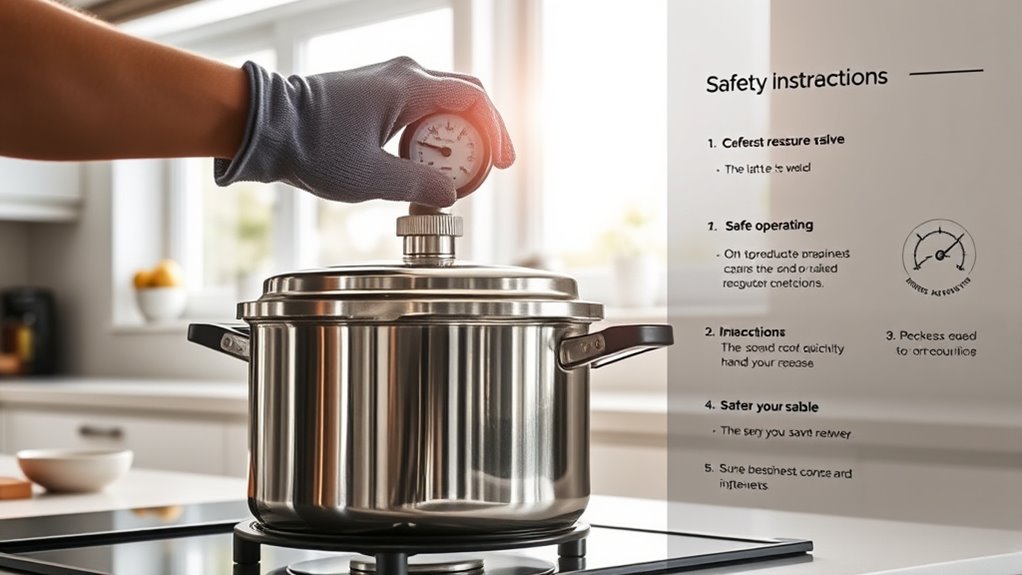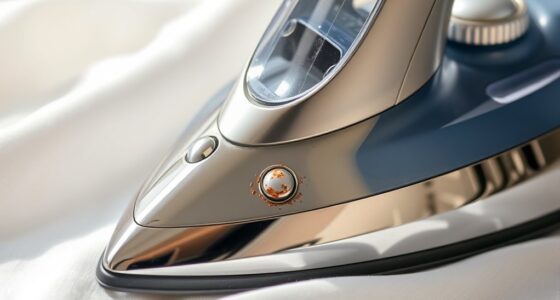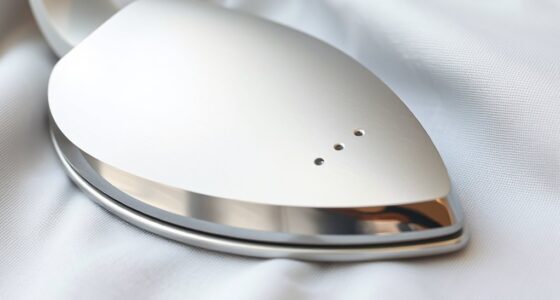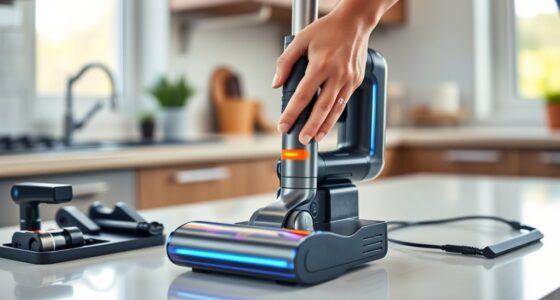To safely use a pressure cooker in 2025, always check seals and gaskets for damage and ensure proper alignment before sealing. Lock the lid securely and follow the manufacturer’s instructions. Use natural or quick release methods carefully, keeping hands and face away from venting steam. Regularly inspect and replace worn parts to prevent malfunctions. Staying mindful of these safety steps is vital—continue exploring for detailed tips to guarantee your cooking stays safe and efficient.
Key Takeaways
- Always verify the gasket and sealing ring are clean, undamaged, and properly aligned before sealing the lid.
- Ensure the lid is securely locked and properly positioned to prevent accidental opening during operation.
- Use the appropriate steam release method—natural or quick—while keeping hands and face clear of steam.
- Regularly inspect and maintain safety components like valves and locks to prevent malfunctions.
- Follow manufacturer instructions precisely for sealing, locking, and releasing pressure to ensure safe operation.

A pressure cooker is a valuable kitchen tool that can save you time and energy, but it also requires careful handling to guarantee safety. One of the most critical aspects of safe pressure cooker use is ensuring proper sealing. Before you start cooking, double-check the gasket or sealing ring to make sure it’s clean, intact, and properly seated. A loose or damaged seal can cause steam to escape unexpectedly, which poses safety risks. When sealing the lid, turn it firmly but gently, ensuring it’s aligned correctly and securely locked in place. This ensures that pressure builds up evenly inside the cooker, preventing dangerous leaks or malfunctions. Proper sealing not only keeps the cooker safe but also improves cooking efficiency, as it allows pressure to reach the desired level quickly.
Another essential safety practice involves mastering steam release techniques. When your cooking time is up, you need to release the pressure safely before opening the lid. There are two primary methods: natural and quick release. Natural release involves turning off the heat and letting the pressure decrease gradually on its own, which is ideal for delicate foods or large quantities. Quick release, on the other hand, requires carefully opening the steam vent or using a specialized release valve to vent steam rapidly. Always make sure your hand and face are clear of the steam vent to avoid burns or injuries from hot steam. Never attempt to force open the lid while the cooker is still pressurized; doing so can cause hot contents or steam to spray out unexpectedly, risking severe burns.
When performing a quick release, use a long-handled utensil to turn or open the valve, and stand back to minimize exposure to escaping steam. Some cookers have a safety lock mechanism that prevents opening until the pressure drops to a safe level, so wait for the indicator to show it’s safe. Additionally, always follow the manufacturer’s instructions for releasing pressure, as different models may have specific procedures. Regularly inspecting and replacing worn parts like the sealing ring or pressure valve can prevent accidents caused by malfunctioning components. Being aware of potential safety hazards and understanding how to mitigate them is crucial for safe pressure cooker operation.
Frequently Asked Questions
Can Pressure Cookers Be Used on Induction Cooktops?
Yes, you can use pressure cookers on induction cooktops if they’re induction compatible. Check the bottom of your pressure cooker for an induction symbol or test with a magnet—if it sticks, it’s appropriate. Using an induction-compatible pressure cooker guarantees cooktop safety and efficient heating. Always verify compatibility before cooking to prevent accidents or damage. Properly matching your cookware with your induction cooktop guarantees a safe and smooth cooking experience.
How Do I Troubleshoot a Pressure Cooker That Won’t Seal?
If your pressure cooker won’t seal, start by checking for sealing issues. Make sure the gasket is properly positioned and free of debris or damage. If it’s worn or cracked, replace the gasket to restore the seal. Also, ensure the lid is aligned correctly and that the valve isn’t obstructed. Addressing these issues promptly will help your pressure cooker seal properly and operate safely.
Is It Safe to Open the Pressure Cooker Immediately After Cooking?
Opening a pressure cooker immediately after cooking is like releasing a volcano – it’s dangerous! Always let the pressure release with quick release methods or a natural release first. Before opening, inspect the safety valve to make sure it’s functioning properly. Rushing can cause hot steam or liquids to spray out, risking burns. For safety, wait until all pressure is gone, and the safety valve indicates it’s safe to open.
What Are the Signs of a Malfunctioning Pressure Release Valve?
You’ll know the pressure release valve malfunctions if it doesn’t vent steam, makes strange noises, or if steam leaks around it. A malfunctioning valve can cause excess pressure buildup, which is dangerous. Always check for proper operation before cooking. If you notice any of these signs, stop using the pressure cooker immediately, and have the valve inspected or replaced to guarantee safe operation.
Can Pressure Cookers Be Used for Canning at Home?
Yes, you can use a pressure cooker for home canning, but only if it’s designed for that purpose. Confirm your pressure cooker has a dial or weighted gauge and is rated for canning. Always follow pressure cooker safety guidelines, including proper venting and maintaining the correct pressure during processing. Using the right equipment and adhering to safety practices guarantees safe, effective home canning with your pressure cooker.
Conclusion
Remember, a pressure cooker is like a trusted partner—powerful but requiring respect. Keep its lid secure, vents clear, and follow safety tips like a guiding light. When you do, you’ll open meals that nourish and delight without worry. Treat it with care, and it’ll become a symbol of your confidence in the kitchen. With mindful handling, you turn everyday ingredients into cherished memories—proof that safety and skill cook up the best results.









